AMD’s Mobile Revival: Redefining the Notebook Business with the Ryzen 9 4900HS (A Review)
by Dr. Ian Cutress on April 9, 2020 9:00 AM ESTRenoir: Latency, Caching, and Turbo
Chiplets vs Monolithic
To date, AMD has launched Desktop Ryzen 3000, Threadripper 3000, and EPYC 7002 (Rome) with Zen 2 cores. For all these products, it has placed its Zen 2 cores inside chiplets that connect to a central IO die, which then talks to other chiplets or the main system. In Ryzen 3000 Desktop, we have one or two chiplets paired with an IO die that can handle 24 PCIe 4.0 lanes and two memory channels. In Threadripper 3000, we have up to eight chiplets with an IO die that can handle 64 PCIe 4.0 lanes and four memory channels. In EPYC 7002 (Rome), we have up to eight chiplets with an IO die that can handle 128 PCIe 4.0 lanes and eight memory channels.
For Ryzen Mobile 4000, there are no chiplets – instead we have a traditional single die, which is referred to as a monolithic design. Both the chiplet design and monolithic designs have various benefits and weaknesses.
For the chiplet design, going that route for expensive processors actually helps with costs, yields, and frequency binning. This has also enabled AMD to launch these products earlier, with the end result being better per-core performance (through binning), taking advantage of different process nodes, and providing an overall chip with more die area than a single chip can provide.
The downside of this chiplet design is often internal connectivity. In a chiplet design you have to go ‘off-chip’ to get to anywhere else, which incurs a power and a latency deficit. Part of what AMD did for the chiplet designs is to minimize that, with AMD’s Infinity Fabric connecting all the parts together, with the goal of the IF to offer a low energy per bit transfer and still be quite fast. In order to get this to work on these processors, AMD had to rigidly link the internal fabric frequency to the memory frequency.
With a monolithic design, AMD doesn’t need to apply such rigid standards to maintain performance. In Ryzen Mobile 4000, the Infinity Fabric remains on the silicon, and can slow down / ramp up as needed, boosting performance, decreasing latency, or saving power. The other side is that the silicon itself is bigger, which might be worse for frequency binning or yield, and so AMD took extra steps to help keep the die size small. AMD was keen to point out in its Tech Day for Ryzen Mobile that it did a lot of work in Physical Design, as well as collaborating with TSMC who actually manufactures the designs, in order to find a good balance between die size, frequency, and efficiency.
The Renoir silicon is ~150 square millimeters. (AMD’s official number is 156 mm2, although some other measurements seem to suggest it is nearer 149 mm2.) In that design is eight Zen 2 cores, up to eight enhanced Vega compute units, 24 lanes of PCIe 3.0, and two DDR4-3200 memory channels. This is all built on TSMC’s 7nm manufacturing process (N7)
Latency
Each of the eight Zen 2 cores is split into a quad-core complex (CCX), which gives each set of four cores access to 4 MB of L3 cache, or a total of 8 MB across the chip. In a chiplet design, there are also eight cores per chiplet (two CCXes), but when one CCX needs to communicate to another, it has to go off chip to the central IO die and back again – inside the monolithic Renoir silicon, that request stays on silicon and has a latency/power benefit. We can see this in our core-to-core latency diagram.
With our 4900HS, we have a 7 nanosecond latency for multithreads pinging inside a core, 17-18 nanosecond latency for threads within a CCX, and a 61-69 nanosecond latency moving across each CCX.
For a Ryzen 9 3950X, with two chiplets, the diagram looks a bit different:
Here we see the same 7 nanoseconds for inside a core, 17-18 nanoseconds between cores in the same CCX, but now we have 81-89 nanoseconds between CCXes in the same chiplet, because we have to go off silicon to the IO die and back again. Then, if we want to go to a CCX on another chiplet, it can take 110-118 nanoseconds, because there’s another hop inside the IO die that needs to occur.
(AMD makes a thread leave the chiplet, even when it’s speaking to another CCX on the same chiplet, because that makes the control logic for the entire CPU a lot easier to handle. This may be improved in future generations, depending on how AMD controls the number of cores inside a chiplet.)
Going back to the Renoir CPU, we can compare this to the Intel Core i7-9750H in our Razer Blade machine:
For the Core i7, we see a similar 7 nanosecond latency for a hyperthread, but in order to access any of the other six cores, it takes 19-23 nanoseconds. This is a tiny bit longer than AMD inside a CCX, because the Intel methodology is a ring-based topology, but Intel has the benefit of it being uniform across the whole chip, enabling the performance to be more consistent as the CPU has an effective homogenous latency. Intel’s ring topology is core count dependent, so more cores means a larger ring and a longer latency, but the variability of the ring becomes bigger (and less power efficient) when the ring gets bigger – this is why we saw dual ring designs in high-core-count Xeon chips for pre-Skylake.
Caching
For Renoir, AMD decided to minimize the amount of L3 cache to 1 MB per core, compared to 4 MB per core on the desktop Ryzen variants and 4 MB per core for Threadripper and EPYC. The reduction in the size of the cache does three things: (a) makes the die smaller and easier to manufacture, (b) makes the die use less power when turned on, but (c) causes more cache misses and accesses to main memory, causing a slight performance per clock decrease.
With (c), normally doubling (2x) the size of the cache gives a square root of 2 decrease in cache misses. Therefore going down from 4 MB on the other designs to 1 MB on these designs should imply that there will be twice as many cache misses from L3, and thus twice as many memory accesses. However, because AMD uses a non-inclusive cache policy on the L3 that accepts L2 cache evictions only, there’s actually less scope here for performance loss. Where it might hurt performance most is actually in integrated graphics, however AMD says that as a whole the Zen2+Vega8 Renoir chip has a substantial uplift in performance compared to the Zen+Vega11 Picasso design that went into the Surface Laptop 3.
For our cache latency structure, we got the following results:
Our results show a worst case scenario with full random access latencies of
- 0.9 nanoseconds for L1 (4 clks) up to 32 KB,
- 3 nanoseconds for L2 (12-13 clks) up to 256 KB,
- 4-5 nanoseconds (18-19 clks) at 256-512 KB (Accesses starting to miss the L1 TLB here)
- 9.3 nanoseconds (39-40 clks) from 1 MB to 4 MB inside the rest of the CCX L3
- 65+ nanoseconds (278+ clks) from 6 MB+ moving into DRAM
It’s important to note that even though the chip has 8 MB of L3 total across the two CCX domains, each core can only access the L3 within its own CCX, and not the L3 of the other CCX domain. So while the chip is correct in saying there is 8 MB of L3 total, no core has access to all the L3. This applies to the desktop and enterprise chips as well (in case it wasn’t explicitly stated before).
Turbo Ramping
One of the key metrics of previous mobile designs is the ability for the core to jump from a low power state to a high power state very quickly, and then back down again. The faster you can do it, the better responsiveness for the user, but it also saves power by not keeping the high power state on for so long. It also helps that the processor ends up with a bunch of instructions to process, it can turbo up before they are finished, otherwise it wastes power doing the turbo for nothing.
For this test, we derive the frequency of a core at a microsecond level with instruction block throughput measurements while the CPU ramps up to its highest turbo state.
Here our Ryzen 9 4900 HS idles at 1.4 GHz, and within the request to go up to speed, it gets to 4.4 GHz (which is actually +100 MHz above specification) in 16 ms. At 16 ms to get from idle to full frequency, we’re looking at about a frame on a standard 60 Hz monitor, so responsiveness should be very good here.
We can compare this to the Core i7-9750H in the Razer Blade:
This processor idles a bit lower, at 1.1 GHz, and then gets to 4.2 GHz at around 39 milliseconds. The thing is though, this isn’t the top turbo frequency. Technically this CPU can get to 4.5 GHz, it even says so on the sticker on the laptop, however we see another small bump up to 4.3 GHz at around 83 milliseconds. So either way, it takes 2-4x longer to hit the high turbo for Intel’s 9th Gen (as setup by Razer in the Blade) than it does for AMD’s Ryzen 4000 (as setup by ASUS).


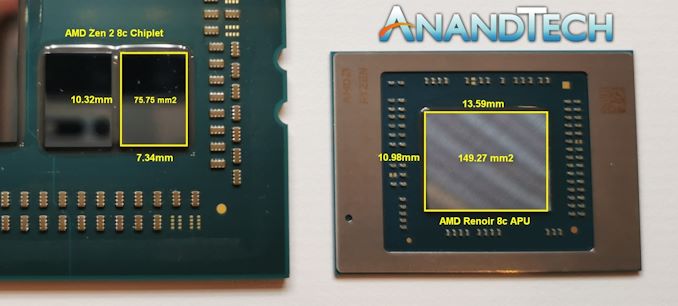
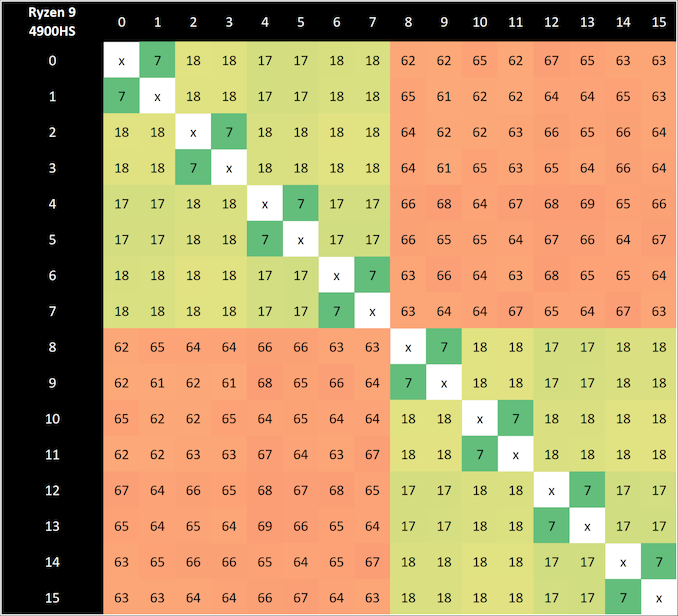

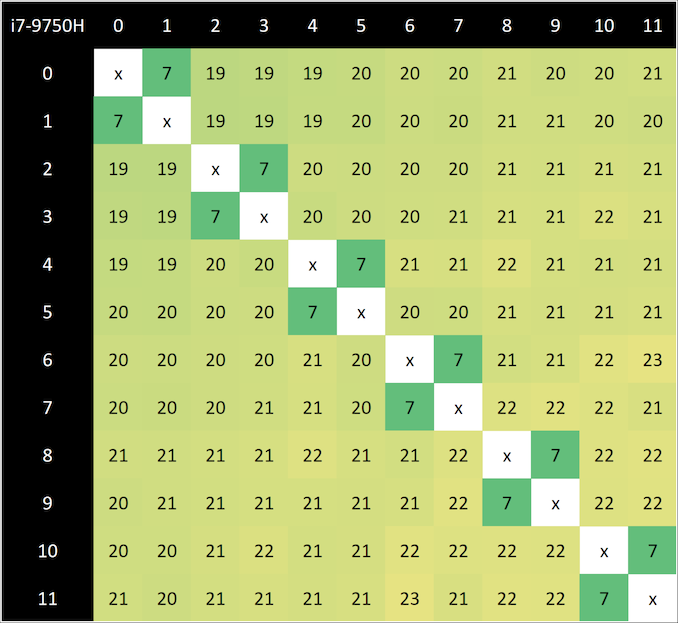
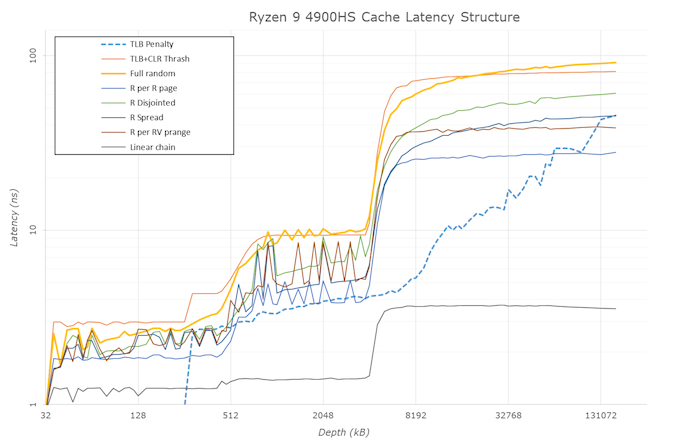
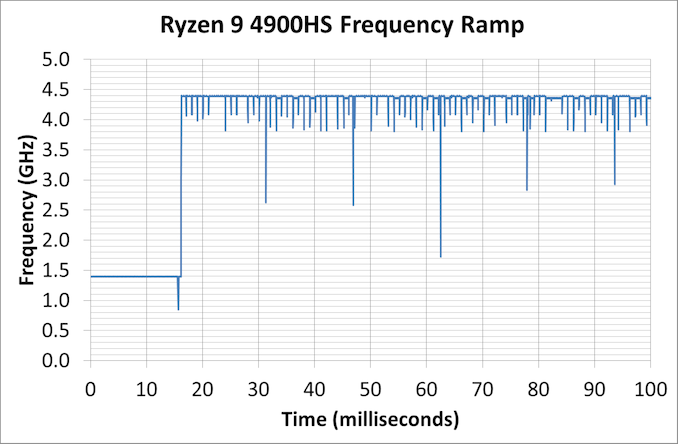
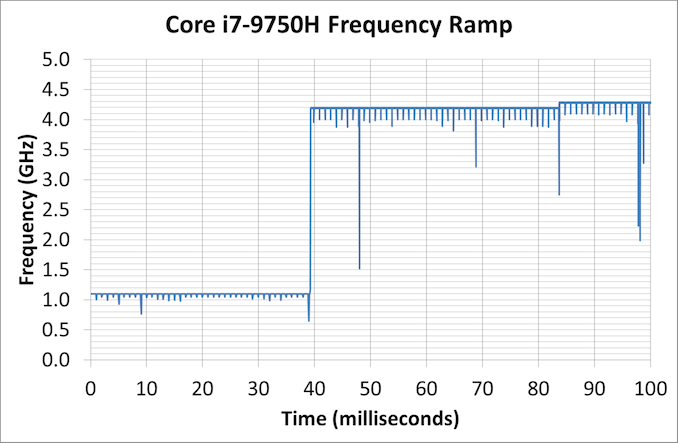








267 Comments
View All Comments
schujj07 - Tuesday, April 14, 2020 - link
@Gondalf you are complaining that this is a 6c/12t vs 8c/16t well here is a review of the same laptop with more competition. https://www.tomshardware.com/reviews/asus-rog-zeph... Included in that is an intel 8c/16t and that still loses. The reason for the 6c/12t laptop in this review is they were comparing laptops of similar price. An equivalent laptop with the Intel 8c/16t CPU runs $2650 or $1200 more than this Asus and that $2650 laptop still loses.@deicidium369 your rant about the gaming desktop you basically copied and pasted for a forum on tomshardware https://forums.tomshardware.com/threads/amd-big-na... Just because you post the same thing in two places doesn't give you more credibility. Also that laptop review I posted from tomshardware does include an Intel Ice-Lake laptop configured to 25W, guess what it still loses. Right now there aren't any reviews of laptops with the Ryzen 4000U series. Once those come out we will be able to see how they do against competing Ice-Lake laptops. My best guess is that the Intel will still lose and it won't matter the core count. Reason for that is across the board the Ryzens will have better base clock speeds regardless of core count. While there are certain tasks that are bursty on laptops, there are others that aren't and take longer to run. Anything that isn't able to burst and has to rely more on base clock will almost for sure be faster on the AMD. Even the 8c/16t 4800U @15W has a higher base clock than the 1065G7 (top of the stack Ice-Lake) @25W: 1.8GHz vs 1.5GHz, at 15W the Intel is only 1.3GHz. Looking at boost clocks the only Ryzen with a lower boost clock than the top of the line Intel is the Ryzen 3 4300U, the bottom stack chip, 3.9GHz Intel vs 3.7GHz Ryzen. All the other Ryzens boost to at least 4.0GHz.
Korguz - Tuesday, April 14, 2020 - link
i looked at that post on toms, JarredWaltonGPU's post regarding him is awesomeschujj07 - Tuesday, April 14, 2020 - link
It is nice to see Jarred Walton doing reviews again. I remember reading his reviews here on anandtech many years ago.blkspade - Saturday, August 1, 2020 - link
@Gondolf - Your arguing against such a comparison misses all of the important details. The 8 core outperforms a more expensive 6 core, while also being more efficient with those extra cores. Even if an equivalent Intel 8 core offering were between on par or better, performance wise, it would be both dramatically more expensive and less efficient. For the potential consumer, that makes it absolutely fair comparison, and one that matters.Viilutaja - Saturday, April 11, 2020 - link
Just check out the 8C vs 8C review's at Youtube! Be glad it was not compared againest the best of Intel mobile 8 cores, because most of them AMD won and even against 80W version of Intel 8core cpu... And there is even faster CPU by AMD 4900H which is 45W part not this 35W part in this review.sharath.naik - Saturday, April 11, 2020 - link
With this, there is no intel product you can buy over AMD. Not in Laptop, not in desktop and not in the server space. Intel is 2 generations behind in performance in all, but in laptops buying an Intel would be a very poor choice, given you have half the performance(I will not count the 5-sec turbo boost that intel gives as legitimate numbers) and poorer battery life.Gondalf - Sunday, April 12, 2020 - link
Too bad the output of these SKUs will be very low.At the end Intel care nothing of there cpus, they will not affect Intel botton line. Only Intel can supply the OEMs channels. This piece of silicon is an intersting but useless experiment.
No volume no money
FreckledTrout - Sunday, April 12, 2020 - link
I would have thought the world's largest fab, TSMC, could make as many chips as needed. Silly me.Qasar - Sunday, April 12, 2020 - link
more lame BS from pro intel gondalfDeicidium369 - Sunday, April 12, 2020 - link
More lame BS from pro AMD qasar.